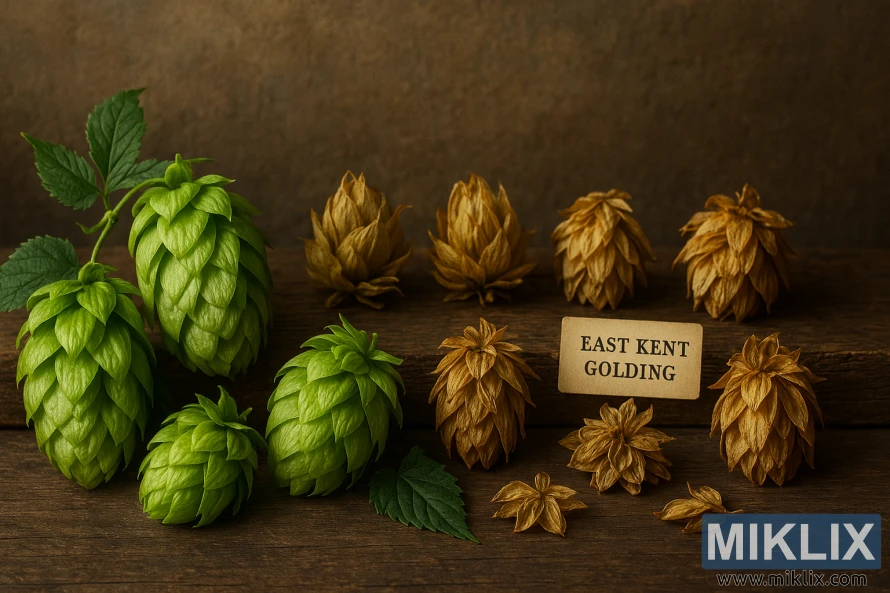Image: Hop Cones Still Life
Published: July 24, 2025 at 6:12:33 PM UTC
Last updated: September 27, 2025 at 12:17:59 PM UTC
Still life of fresh and dried hop varieties, including East Kent Golding, displayed on a rustic backdrop highlighting artisanal brewing.
Arranged with deliberate care and illuminated by warm, natural light, this still life captures both the beauty and the utility of one of brewing’s most celebrated ingredients: hops. In the foreground, a cluster of fresh, vibrant green cones lies partially entwined with leafy stems, their layered bracts overlapping like tiny scales on a pinecone. Each fold conceals the golden lupulin glands within, a treasure trove of essential oils and resins that impart the bitterness, aroma, and complexity so vital to beer. The cones appear plump and well-formed, suggesting peak ripeness and evoking the freshness of a late summer harvest. Their color—a luminous green—seems to glow against the darker, earthen backdrop, drawing the viewer’s attention immediately to the vitality of the living plant.
Behind them, forming a deliberate contrast, sits a collection of dried hop cones, their bracts curled inward and tinged with shades of gold and deep russet. These are East Kent Golding hops, a storied English variety that has played a defining role in traditional brewing for centuries. A small sign identifies them, lending the arrangement both an educational and archival quality, as though the scene might belong in a botanical study or a brewer’s handbook. The dried hops, with their papery texture and muted tones, represent not just a different stage of the plant’s lifecycle but also a different stage in its use. While the fresh cones symbolize potential, the dried ones embody readiness, carefully preserved for brewing and valued for their consistency, subtlety, and timeless character.
The wooden surface beneath the hops, weathered and textured, enhances the rustic mood of the composition. It suggests the craft origins of brewing, evoking imagery of wooden barns, drying lofts, and the quiet patience of traditional hop farmers. The soft shadows cast by the lighting accentuate the details of each cone, from the delicate ridges of the bracts to the subtle glimmer of lupulin peeking through. The contrast between the living green and the dried gold creates a visual dialogue: one embodies growth and energy, the other maturity and preservation. Together they tell the story of hops as both agricultural product and brewing ingredient, reminding us of the cycles of nature and the human ingenuity used to harness them.
The overall composition balances artistry with functionality, much like brewing itself. By highlighting East Kent Golding hops specifically, the image calls attention to their historical importance. Renowned for their earthy, floral, and gently spicy character, East Kent Goldings have long been a cornerstone of English ales, bitters, and porters, prized for their ability to impart complexity without overwhelming the palate. Their inclusion here serves as both tribute and lesson, reminding the viewer of the profound influence that one variety of hops can exert on the taste and culture of beer.
This still life is more than a botanical study; it is a meditation on transformation. The fresh green cones, brimming with untapped potential, and the dried golden ones, prepared for the brewer’s hand, symbolize the journey of hops from field to kettle. The rustic wood and warm light underscore the artisanal spirit of brewing, while the careful arrangement invites viewers to appreciate hops not just as an ingredient but as a central protagonist in the timeless story of beer.
The image is related to: Hops in Beer Brewing: East Kent Golding

